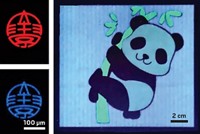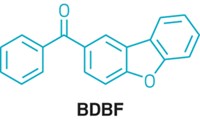Advertisement
Grab your lab coat. Let's get started
Welcome!
Welcome!
Create an account below to get 6 C&EN articles per month, receive newsletters and more - all free.
It seems this is your first time logging in online. Please enter the following information to continue.
As an ACS member you automatically get access to this site. All we need is few more details to create your reading experience.
Not you? Sign in with a different account.
Not you? Sign in with a different account.
ERROR 1
ERROR 1
ERROR 2
ERROR 2
ERROR 2
ERROR 2
ERROR 2
Password and Confirm password must match.
If you have an ACS member number, please enter it here so we can link this account to your membership. (optional)
ERROR 2
ACS values your privacy. By submitting your information, you are gaining access to C&EN and subscribing to our weekly newsletter. We use the information you provide to make your reading experience better, and we will never sell your data to third party members.
Synthesis
Light-Emitting Metallacycles Put Themselves Together
ACS Meeting News: Coordination-driven self-assembly leads to platinum-organic complexes for optoelectronic and biomedical applications
by Stephen K. Ritter
March 25, 2015
| A version of this story appeared in
Volume 93, Issue 13

Tol = toluene, THF = tetrahydrofuran, EA = ethyl acetate, BA = butyl acetate, Dio = dioxane, MeOH = methanol.
Chemists are often described as being molecular architects. Nowhere is that moniker more appropriate than for the researchers who recently created a collection of light-emitting platinum-organic metallacycles and metallacages. Peter J. Stang of the University of Utah described the self-assembling supramolecular coordination complexes this week in lectures in the Divisions of Fluorine and Inorganic Chemistry at the American Chemical Society national meeting in Denver.

By selecting combinations of linear and angular metal complexes and organic linking groups, researchers such as Stang and his colleagues can build two- and three-dimensional molecules with fantastic geometries and versatile properties. The scientists are exploring the molecules as optoelectronic chemical sensors, as building blocks for polymeric hydrogels and fibers, as bioprobes for visualizing and monitoring physiological processes, and as therapeutics.
Stang described one study, led by J. Bryant Pollock in his group, in which researchers coupled bis(ethynylpyridine)aniline ligands with a platinum phenanthrene complex to form rhombus-shaped rings. The color of light the molecules emit when they fluoresce can be tuned to span the visible spectrum by changing substituents on the aniline ring. Working with Bogdan Z. Olenyuk’s group at the University of Southern California, Stang’s team showed that the rhomboidal metallacycles get slurped up by tumor cells and have anticancer activity—a first for supramolecular coordination complexes, Stang believes. The molecules potentially could be developed for image-guided drug delivery.
Stang also reported a collaboration with Xuzhou Yan and Feihe Huang of China’s Zhejiang University to link a pyridyl-functionalized tetraphenylethylene, a benzene dicarboxylate, and a platinum phosphine complex to create metallacages that can be decorated with functional groups such as sugars on the outside and house molecules up to the size of enzymes on the inside.
These 3-D metallacages maintain their light emission when they are discrete molecules in dilute solution or when they aggregate together in high concentrations. Other such “luminophores” tend to self-quench and extinguish themselves at high concentrations or fall dark when aggregates come apart at low concentrations, Stang explained. The metallacage light emission does, however, change with solvent polarity and solvation power, which offers an easy way to tune the color and intensity of light emitted by the complexes—including white light—simply by changing solvent.
“These metallacycles are a great contribution to the search for luminescent materials with macroscopic processability and multifaceted functionality,” said Ben Zhong Tang of Hong Kong University of Science & Technology, who discovered the aggregation-induced-emission phenomenon.
Metal-organic frameworks have attracted attention as functional hybrid materials, Tang added, but they are insoluble in common solvents and difficult to process. Stang’s supramolecular coordination complexes overcome that limitation, he said. The fact that they can emit white light, Tang observed, “is remarkable because conventional white-light emitters are usually blends of multiple components in mixtures of two or more solvents.”





Join the conversation
Contact the reporter
Submit a Letter to the Editor for publication
Engage with us on Twitter